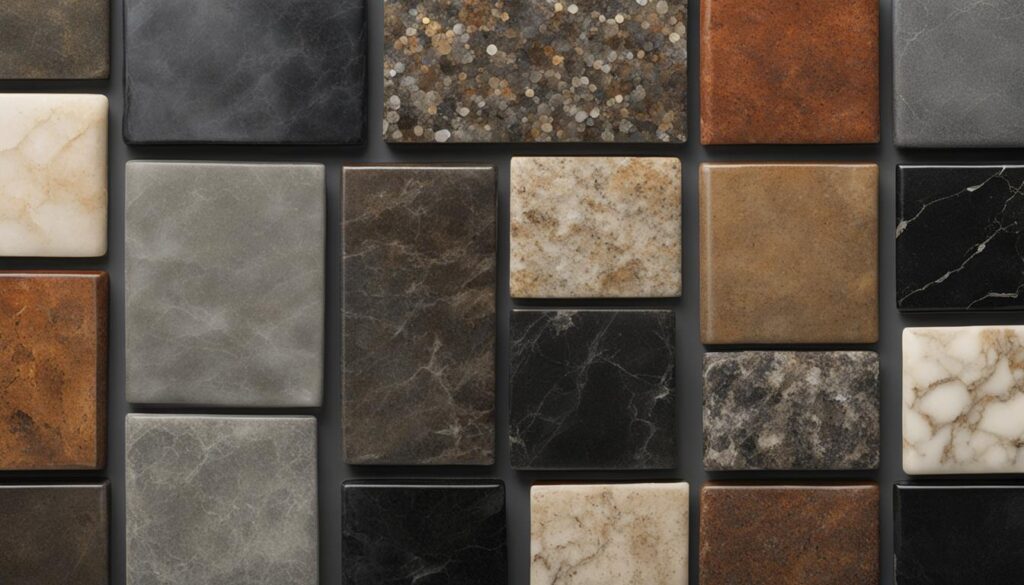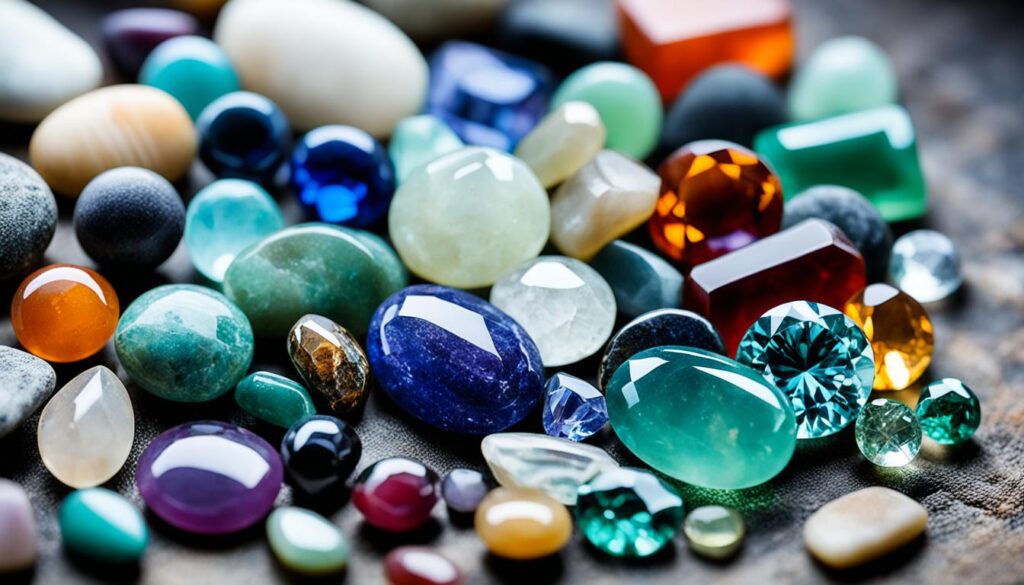Discover the Hardest Natural Stone in the World
When it comes to natural stone, one stands out as the undisputed champion in terms of hardness. Diamond, known for its brilliance and beauty in jewelry, also holds the title for being the hardest natural material in the world. The durability and resilience of diamond have made it the go-to stone for engagement rings and other precious jewelry pieces.
While diamond may be the hardest natural stone, it’s important to note that hardness is not the only characteristic to consider when evaluating stones. Other factors such as brittleness and wearability also play a role in determining the suitability of a stone for various purposes.
Key Takeaways:
- Diamond is the hardest natural stone in the world.
- Hardness is just one factor to consider when evaluating stone materials.
- Diamond’s hardness makes it a popular choice for jewelry.
- Wearability and resilience are important considerations alongside hardness.
- Diamond’s durability has earned it its status as a top stone material.
Understanding Gemstone Hardness
Gemstone hardness is a scientific term that refers to a mineral’s ability to resist scratching. It is determined by the bonds that hold the atoms together within the crystal structure of the gemstone. Understanding gemstone hardness is essential when choosing and wearing jewelry, as it directly impacts the stone’s wearability and scratch resistance.
The most widely recognized scale used to measure gemstone hardness is the Mohs scale, named after Friedrich Mohs who established it in 1812. This scale ranks ten common minerals based on their relative hardness. The higher the ranking, the harder the mineral. Diamond, the hardest natural material, sits at the top of the scale with a hardness of 10, while talc, a soft mineral, sits at the bottom with a hardness of 1.
It’s important to note that the difference in hardness between minerals on the Mohs scale is not linear. For example, diamond is not simply twice as hard as corundum (hardness of 9); it is significantly harder. This nonlinear relationship emphasizes the scientific meaning of hardness and the varying levels of scratchability between different gemstones.
The Mohs Scale of Hardness
The following list showcases the ten common minerals ranked on the Mohs scale:
- Diamond
- Corundum
- Topaz
- Quartz
- Orthoclase Feldspar
- Apatite
- Fluorite
- Calcite
- Gypsum
- Talc
To provide a visual representation of the Mohs scale of hardness, here is an image:
As depicted in the image, a mineral can scratch any mineral with a lower number on the scale while being scratched by any mineral with a higher number. This scale forms the foundation for understanding gemstone hardness and aids in determining the appropriate use and care of gemstones in jewelry and other applications.
The Importance of Gemstone Wearability
Gemstone wearability is a crucial factor to consider when choosing jewelry. It refers to a stone’s ability to withstand scratches and other damage, ensuring that your precious gemstone jewelry can be enjoyed for years to come.
Hardness plays a significant role in gemstone wearability. It is a measure of a gemstone’s resistance to scratching. Softer gemstones, such as opal or pearl, are more prone to scratches compared to harder ones like diamond or sapphire. When a gemstone is scratched, its surface may become dull and lose its luster.
However, gemstone wearability is not solely determined by hardness. Other factors, such as sensitivity to temperature and chemicals, can also affect a gemstone’s ability to withstand everyday wear. Some gemstones may be more vulnerable to damage when exposed to heat or certain chemicals. It is important to consider these factors and take appropriate precautions to preserve the beauty of your gemstone jewelry.
Gemstone cleavage is another essential consideration for wearability. Cleavage refers to the tendency of a mineral to break along specific planes. Gemstones with perfect cleavage, like emerald or topaz, can be more fragile and prone to damage than those without cleavage. The presence of cleavage planes increases the risk of cracks or fractures, compromising the durability of the gemstone.
In summary, gemstone wearability encompasses a combination of factors, including hardness, sensitivity to temperature and chemicals, and cleavage. By selecting gemstones with high wearability, you can ensure that your jewelry remains beautiful and intact, with minimal risk of scratches or damage.
In the next section, we will explore the unique qualities of various gemstones and their suitability for different types of jewelry settings.
The Mohs Scale of Hardness for Countertop Materials
When it comes to selecting the right countertop material, hardness and durability are essential factors to consider. The Mohs scale of hardness, commonly used to measure the hardness of minerals and gemstones, can also be applied to evaluate the hardness of various countertop materials. Understanding the hardness ranking can help you make an informed decision and choose a countertop material that will withstand everyday wear and tear.
On the Mohs scale of hardness, granite and gemstone are at the top, both ranking at an impressive 8. This makes them highly resistant to scratching and damage, making them excellent choices for those seeking durable countertops. Quartzite, quartz, and onyx follow closely behind, with a hardness ranking of 7. These materials are still quite resilient but may require slightly more care compared to granite and gemstone.
For individuals seeking a slightly less hard surface, marble, travertine, and slate are options to consider. These materials have a hardness ranking of 4 on the Mohs scale. While they are still robust and can withstand daily use, they may be more prone to scratches and require a bit more maintenance to preserve their appearance.
On the softer end of the scale, we have limestone and soapstone, with hardness rankings of 3 and 1, respectively. While these materials may offer unique visual appeal, they are more susceptible to scratches and damage and require extra care and caution during use and maintenance.
Countertop Material Hardness Ranking on the Mohs Scale:
| Material | Mohs Scale Hardness |
|---|---|
| Granite | 8 |
| Gemstone | 8 |
| Quartzite | 7 |
| Quartz | 7 |
| Onyx | 7 |
| Marble | 4 |
| Travertine | 4 |
| Slate | 4 |
| Limestone | 3 |
| Soapstone | 1 |
When selecting a countertop material, it’s crucial to consider your lifestyle, budget, and aesthetic preferences in addition to hardness. While harder materials like granite and gemstone offer excellent durability, they may come at a higher cost. Softer materials like marble and travertine can still provide a beautiful look but may require more maintenance to keep them looking their best.
By understanding the hardness ranking of countertop materials on the Mohs scale, you can make an informed decision and choose a material that aligns with your needs and expectations. Whether you prioritize extreme hardness or value aesthetics, there’s a countertop material available to suit your unique requirements.

Choosing the Best Countertop Material for Hardness
When it comes to selecting a countertop material, hardness is often a key consideration. Hardness is a measure of a material’s resistance to scratching, making it an important factor in determining the durability of a countertop. Two of the best choices for hardness are granite and gemstone.
Granite is a popular option for countertops due to its exceptional hardness. Ranking at 8 on the Mohs scale, granite is highly resistant to scratches and can withstand daily use without showing signs of wear. In addition to its hardness, granite also offers a wide range of colors and patterns, making it a versatile choice for any kitchen or bathroom.
Gemstone countertops, such as those made from quartz or quartzite, are another excellent choice for hardness. These materials rank similarly to granite on the Mohs scale and provide exceptional durability. Gemstone countertops can also add a touch of elegance and uniqueness to any space, with their natural beauty and stunning patterns.
While both granite and gemstone are excellent choices for hardness, there are other factors to consider when selecting a countertop material. Budget, for example, may play a role in your decision. Granite tends to be more affordable compared to gemstone, making it a popular choice for many homeowners.
Moreover, durability and maintenance should also be taken into account. Some countertop materials, like soapstone, may be more prone to scratching due to their lower hardness rating. However, soapstone develops a graceful patina over time, adding character to the countertop.
Ultimately, the best countertop material for hardness will depend on your specific needs and preferences. Granite and gemstone offer excellent durability and scratch resistance, making them ideal choices for high-traffic areas. Consider your budget and desired maintenance level to find the perfect countertop material that combines both hardness and practicality.
Understanding Hardness and Toughness in Gemstones
Gemstones exhibit different characteristics that contribute to their overall durability. Two key factors to consider are hardness and toughness. While these terms are often used interchangeably, they have distinct meanings in the world of gemology.
Hardness refers to a gemstone’s resistance to scratching. It measures the strength of the bonds between the atoms within its crystal structure. The Mohs scale, developed by Friedrich Mohs, provides a standardized ranking of mineral hardness from 1 to 10, with 10 being the hardest. For example, diamond, the hardest natural material, has a hardness of 10 while talc, the softest, has a hardness of 1.
Toughness, on the other hand, measures a gemstone’s resistance to fracture when subjected to external force or impact. It is not directly related to hardness but instead evaluates a stone’s ability to withstand breaking or chipping. A gemstone with high toughness can endure more rough handling without sustaining damage.
Cleavage is another factor that influences the durability of a gemstone. It refers to the propensity of a mineral to break along certain planes, resulting in smooth, flat surfaces. Gemstones with perfect cleavage are more prone to splitting, making them less durable compared to those with no cleavage or poor cleavage.
Stability is a crucial consideration as well. Some gemstones may be affected by exposure to chemicals, temperature changes, or light, causing them to lose color or degrade over time. An understanding of a gemstone’s stability can help ensure its long-term beauty and value.
To better illustrate these concepts, refer to the table below:
| Gemstone | Hardness (Mohs scale) | Toughness | Cleavage |
|---|---|---|---|
| Diamond | 10 | Excellent | None |
| Sapphire | 9 | Excellent | Poor |
| Emerald | 7.5-8 | Good to Poor | Poor |
| Opal | 5.5-6.5 | Poor | Perfect |
Understanding the interplay between hardness, toughness, cleavage, and stability is essential when selecting gemstones for jewelry or other purposes. A balance of these factors will ensure that the gemstone not only showcases its inherent beauty but also withstands the tests of time.
The Role of Jewelry Settings in Gemstone Wearability
Jewelry settings play an important role in ensuring the wearability of gemstones. Different settings can provide varying levels of protection, especially for soft gemstones that are more prone to damage. When it comes to selecting the appropriate setting for your gemstone, factors such as the type of jewelry and the wearability grade of the gemstone should be taken into consideration.
Rings: Rings are commonly subjected to more wear and tear compared to earrings or pendants. This is because rings are exposed to constant contact and potential impact as we use our hands throughout the day. Therefore, it is crucial to choose a setting that offers sufficient protection for your gemstone.
Soft Gemstones: Soft gemstones, particularly those with a wearability grade of “Poor,” require extra care to prevent damage. These gemstones are more susceptible to scratches, chips, and other forms of wear. When setting soft gemstones, it is advisable to opt for protective settings that provide additional support and coverage, minimizing the risk of damage.
Inlay Ring Settings: Inlay ring settings are a popular choice for protecting soft gemstones. These settings involve embedding the gemstone into a surrounding metal, providing a secure and shielded environment. Inlay ring settings help prevent direct contact and minimize the exposure of the gemstone’s vulnerable edges to potential damage.
When selecting a jewelry setting for your gemstone, it is essential to consult a professional jeweler who can offer guidance based on the wearability grade and specific requirements of your gemstone. By choosing an appropriate setting, you can enhance the longevity and beauty of your gemstone jewelry.
Key Takeaways:
- Rings are more prone to damage compared to earrings or pendants.
- Soft gemstones require protective settings to minimize the risk of damage.
- Inlay ring settings offer enhanced protection for soft gemstones.
- Consult a professional jeweler to choose the most suitable setting for your gemstone.
How the Mohs Hardness Scale Helps in Choosing Stone Countertops
The Mohs hardness scale is a valuable tool when it comes to selecting stone countertops for your home. By understanding the hardness of different stone countertop materials, you can make an informed decision that aligns with your needs for durability and maintenance.
Countertops made from materials with a higher ranking on the Mohs scale are less susceptible to scratches and damage. For example, granite and gemstone, which both have a high ranking on the scale, provide excellent resistance to scratches, making them popular choices for countertop materials. On the other hand, softer stone countertops like marble and travertine require more care to avoid scratches.
Here is a breakdown of the hardness ranking of various stone countertop materials according to the Mohs scale:
| Stone Countertop Material | Mohs Hardness Scale Ranking |
|---|---|
| Granite | 8 |
| Gemstone | 8 |
| Quartzite | 7 |
| Quartz | 7 |
| Marble | 4 |
| Travertine | 4 |
As shown in the table above, granite and gemstone, with their higher rankings, offer superior hardness compared to marble and travertine. If you prioritize scratch resistance, opting for a stone countertop material like granite or gemstone would be the best choice.
The importance of the Mohs hardness scale in selecting stone countertops lies in its ability to help you gauge the durability and longevity of the material. By considering the hardness of different stone countertop materials, you can ensure that your countertops will stand up to daily use without showing signs of wear and tear.
Other Measures of Hardness in Gemstones
The Vickers Hardness Scale is another measure of hardness that provides valuable insights into the durability and strength of gemstones. It takes into account the indent made by a specifically shaped diamond on the material, offering precise measurements that go beyond the Mohs scale. While the Mohs scale is widely used in gemology, the Vickers scale allows for a more accurate comparison between different stones.
For instance, according to the Vickers scale, diamonds are approximately 300% harder than corundum (sapphire and ruby) which showcases the significant disparity in hardness between these two gemstones. Such detailed measurements provide gemologists, jewelers, and consumers with a deeper understanding of the relative hardness of different gemstone varieties.
The Vickers Hardness Scale is often used alongside the Mohs scale to complement and enhance hardness evaluations. The combination of these scales offers comprehensive insights into the durability, scratch resistance, and wearability of gemstones, aiding in the selection and appreciation of these precious stones.
Comparison of Hardness between Diamonds and Corundum
| Gemstone | Hardness on the Mohs Scale | Hardness on the Vickers Scale |
|---|---|---|
| Diamond | 10 | 10000 |
| Corundum | 9 | 2800 |
Table: A comparison of hardness values between diamonds and corundum on the Mohs and Vickers scales.
Considerations When Selecting a Durable and Beautiful Gemstone
When it comes to selecting a gemstone for jewelry or other purposes, several factors should be considered to ensure both durability and aesthetic appeal. Gemstone durability is influenced by various characteristics, including hardness, toughness, and stability. By evaluating these aspects, individuals can make informed choices that align with their preferences and requirements.
Gemstone Hardness: Resistance to Scratching
Gemstone hardness refers to a mineral’s resistance to scratching and is an essential aspect of durability. Hardness is measured on the Mohs scale, which ranks gemstones on a scale from 1 to 10. Diamonds top the scale with a hardness of 10, while talc is the softest mineral, scoring a 1. Higher hardness indicates a gemstone’s ability to withstand abrasions and maintain its surface integrity.
When selecting a gemstone, consider the hardness levels required for its intended use. For example, a gemstone used in a ring or bracelet may require a higher hardness to resist the potential wear and tear from daily activities. On the other hand, a gemstone used in a necklace or earrings may not require the same level of hardness since it is less likely to come into contact with hard surfaces.
Gemstone Toughness: Resistance to Fracture
Toughness measures a gemstone’s ability to resist fractures and breakage when subjected to impact or force. A stone’s toughness is influenced by its internal structure and the bonds holding its atoms together. Gemstones that are rated high on both hardness and toughness offer superior durability.
However, it’s important to note that a high level of hardness does not guarantee high toughness. Some gemstones, while extremely hard, may exhibit lower toughness and be more susceptible to breakage. Considering the intended use and potential exposure to impact is essential when selecting a gemstone with the appropriate toughness.
Gemstone Stability: Resistance to Color Loss and Deterioration
Stability refers to a gemstone’s ability to resist color loss and deterioration over time. Some gemstones may be sensitive to environmental factors, including exposure to light, heat, chemicals, or even everyday wear. These factors can cause color fading or changes in the gemstone’s appearance.
When choosing a gemstone, consider its stability based on its chemical composition and known reactions to external influences. Certain gemstones, such as diamonds and sapphires, are highly stable and can withstand prolonged exposure to various conditions. On the other hand, gemstones like opals or certain organic materials may require more careful handling and limited exposure to prevent color loss or damage.
Choosing the Perfect Gemstone
When selecting a gemstone, it’s crucial to find the right balance between durability and aesthetic appeal. Here are a few considerations to keep in mind:
- Identify the intended use of the gemstone, taking into account potential exposure to impact or scratching.
- Research the hardness and toughness ratings of different gemstones to determine which ones best suit your needs.
- Consider the gemstone’s stability in relation to its expected environment and exposure to various elements.
- Examine the gemstone’s appearance, including its color, clarity, and overall visual appeal.
- Consult a trusted gemstone professional or jeweler for expert advice on gemstone selection based on your specific requirements.
Selecting a gemstone that possesses the desired characteristics of durability, hardness, toughness, and stability ensures a beautiful and long-lasting gemstone that will stand the test of time.
| Gemstone | Hardness | Toughness | Stability |
|---|---|---|---|
| Diamond | 10 | Excellent | High |
| Quartz | 7 | Good | High |
| Opal | 5.5-6.5 | Fair to Poor | Moderate |
| Pearl | 2.5-4.5 | Poor | High |

Conclusion
The hardness of a natural stone or gemstone is a crucial factor to consider when choosing materials for countertops or jewelry. The Mohs scale of hardness provides a standardized reference point for evaluating the wearability and durability of minerals and gemstones. By understanding the hardness of different materials, individuals can make informed decisions based on the level of durability required for their specific needs.
When selecting countertops, granite and gemstones such as quartz and quartzite are among the hardest materials available, offering excellent resistance to scratching and damage. On the other hand, softer options like marble, travertine, and slate require more care and maintenance to prevent scratches.
In the realm of gemstones, hardness affects not only the stone’s resistance to scratches but also its wearability and longevity. Harder gemstones like diamond and corundum are better suited for frequent use as they can withstand everyday wear and tear. Soft gemstones, while often beautiful, may require more protective settings to prevent damage.
Ultimately, by considering factors such as hardness, toughness, and stability, individuals can choose durable and beautiful natural stone materials that meet their specific needs, whether it’s for countertops or jewelry. Understanding the importance of hardness in natural stones allows for informed decision-making and ensures long-lasting satisfaction with the chosen materials.



